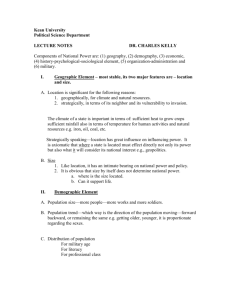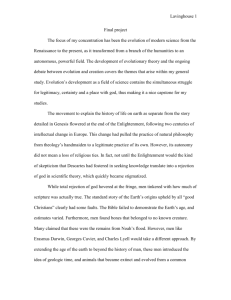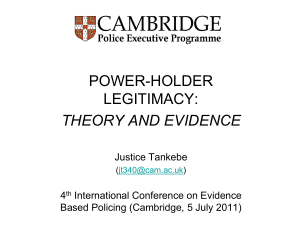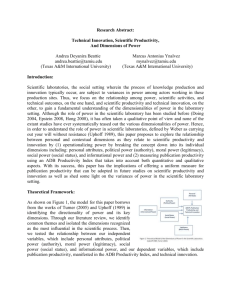Lecture notes: “Why are some countries rich and others poor
advertisement
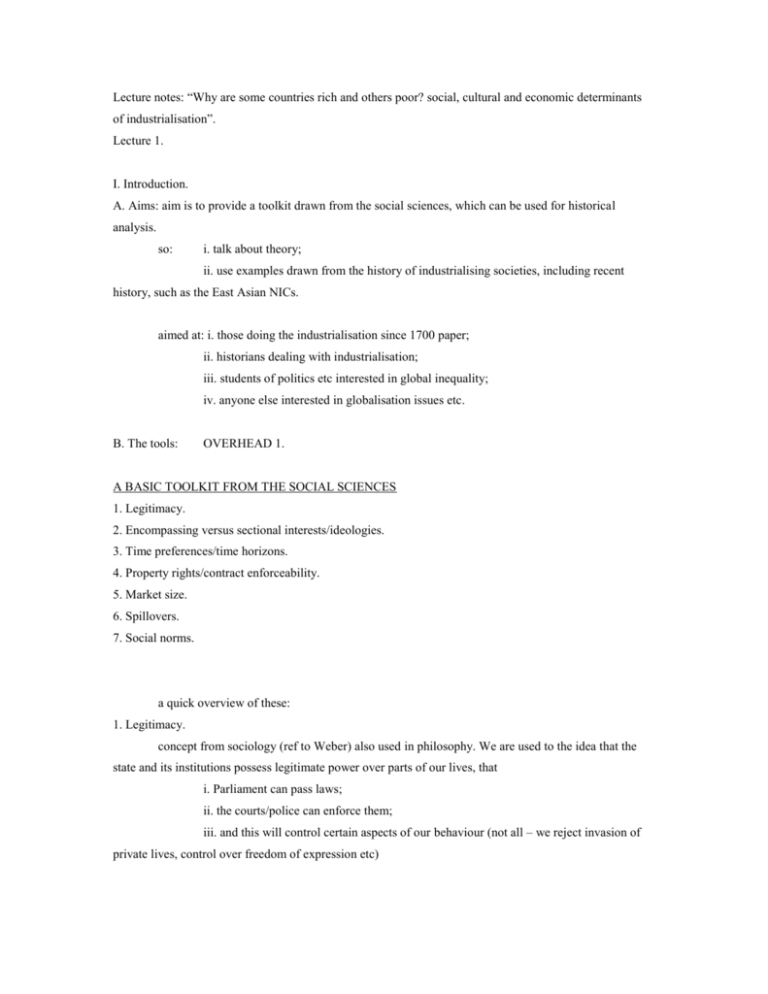
Lecture notes: “Why are some countries rich and others poor? social, cultural and economic determinants of industrialisation”. Lecture 1. I. Introduction. A. Aims: aim is to provide a toolkit drawn from the social sciences, which can be used for historical analysis. so: i. talk about theory; ii. use examples drawn from the history of industrialising societies, including recent history, such as the East Asian NICs. aimed at: i. those doing the industrialisation since 1700 paper; ii. historians dealing with industrialisation; iii. students of politics etc interested in global inequality; iv. anyone else interested in globalisation issues etc. B. The tools: OVERHEAD 1. A BASIC TOOLKIT FROM THE SOCIAL SCIENCES 1. Legitimacy. 2. Encompassing versus sectional interests/ideologies. 3. Time preferences/time horizons. 4. Property rights/contract enforceability. 5. Market size. 6. Spillovers. 7. Social norms. a quick overview of these: 1. Legitimacy. concept from sociology (ref to Weber) also used in philosophy. We are used to the idea that the state and its institutions possess legitimate power over parts of our lives, that i. Parliament can pass laws; ii. the courts/police can enforce them; iii. and this will control certain aspects of our behaviour (not all – we reject invasion of private lives, control over freedom of expression etc) Note: many states do contain people who reject legitimacy of state – e.g. Catholics in Northern Ireland . proposition: no state will industrialise successfully when there is active disagreement over the legitimacy of the government, over the boundaries of the state or when the basic principles of the legal system are contested. historically: this is pretty much the case – Tsarist Russia came close, (what happened to them!) possibly Spain under Franco (post Civil war passivity), might also mention Chile- Pinochet. example: nineteenth century Germany – considerable disagreement over the future of society, but basically a law-abiding country → 2 directions of analysis: i. point that many states may have serious problems of legitimacy e.g. post-colonial societies. ii. historical analysis of the sources of legitimacy→ form of historical sociology going back to Max Weber, Michael Mann is a recent example. Basic argument: societies struggled to find sources of legitimising authority – see extract from Richard II – and found these in the major religions which emerged (or were codified) in the first millennium AD → comparative study of major religions (including Confucianism). But: religions are not just legimising authorities – they are also a “cosmology”, a unified view of human existence and purpose → a set of values which affect the legal system, political structures etc And: not all religions are equally well suited to economic success → view that western economic success had roots in the cosmology of Christianity, or Judeo-Christianity, or Greek-Judeo-Christianity. → search for natural laws, due to: rational view of existence also → application of legal principles. Comment: 1. a view that can not be easily proved or disproved (no natural experiments) 2. undeniably, societies do need sources of legitimacy: and the typical modern solution – the nation state organised as a constiutional democracy – is a historical construct, and should be analysed as such. The question of why we accept the authority of a particular state cannot just be ignored. 2. Encompassing versus sectional interests/ideologies. Concept taken from political science – the work of Mancur Olson in particular. Origins: 1. rational choice view of state action: state maximises its own revenue. 2. similar view of other institutions → rent-seeking behaviour: all seek to maximise income of their members without concern for general good → conflict of interests: 1. by rent-seeking behaviour (charging monopoly prices, driving up wages etc) institutions gain share for members, but reduce overall income level in society as a whole. 2. if sufficently encompassing – inclusive or representative of society as a whole – then the interest of promoting the wealth of society as a whole will tend to dominate over the gains made by increasing group shares example: representative democracy – a small group of c600 will, it is hoped, act to promote the general good, if all sections of society are represented (women? minorities?) = encompassing institution. Need to add ideology (not in Olson) – encompassing ideologies can cause sectional interests to behave in an encompassing way. Comment: 1. Olson’s vision of a soceity brought down by competing sectional interests has yet to be realised – too pessimistic a view of human development. 2. even if Olson’s analysis is flawed, or taken too far, this is a useful analytical tool: it can be applied to trade union structures (vertical versus horizontal structures – craft based unions versus encompassing industry based unions), to political systems (does first past the post promote encompassing parties, and PR sectional ones?), the case for federal constitutions with built in powers for local government etc. 3. we need to apply this concept flexibly. The encompassing institution can be a form of government, a political party, even a single family (the Nehru-Gandhi dynasty in India). 3. Time preferences/time horizons. Generally important in theoretical analysis. 1. In investment functions, there will be more investment if pay-off period is longer, if the time discount factor applied to future earnings is lower. 2. in game theory, with repeated games, people care more about reputation (→ less cheating) and will see more gains from cooperation (→ more social interaction and more institution building) → questions: 1. is the state far-sighted? 2. why should democratic politicans, elected for 4 years or so, not maximise their own income for that period, and ignore the (uncertain) prospect of being re-elected? 3. how can an institution be far-sighted? How can we build such an institution? Comment: 1. vast area of applications, not possible to cover all of these 2. always an important point to bear in mind – what are the time horizons of politicans, businessmen, bureaucrats etc. 4. Property rights/contract enforceability. Concept much used in economic history – new institutional economics. Who owns what? If there are disputes, who decides? And how are sanctions imposed on cheaters? Main ref. is to North, and also to North & Thomas. For investment, need to know who owns the property where the building/factory etc is constructed, need to have certain rights to the flow of profits, rents and other rewards, need also to know the tax rate that will be imposed. → need for credible commitments, not just a promise to respect property rights, but some commitment that this will be carried out (= a cost to the offender). Also → private commitment problems ( a merchant who sends off a cargo needs to know that he/she will eventually be paid), and a need for merchant law (ideally applicable in different cities) and a system for the enforcement of contracts. Comment: 1. undeniably important. 2. do we need absolute titles of ownership, fully transferable at will, or just predictable rights or sharing systems (pre-industrial land tenure systems or modern China – ref. to Oi) 3. can contract systems emerge spontaneously as a result of communal values, or do we need government sanctions? Can there be a non-governmental enforcement system? 5. Market size. Important in economics (growth theory since Adam Smith) and also in geography. Ref is to Sachs and Gallup – show importance of factors such as access to the sea or major rivers, malaria incidence etc Rewards to investment, innovation, the creation of new property rights etc will be related to the size of the market, either internal or external: Isssues: 1. land-locked or coastal? 2. size of internal market 3. internal transport possibilities: navigable rivers versus deserts/mountains. 4. density of population: easier to trade if denser 5. ecological diversity: sea-forest-towns-lowland cereals-highland livestock-nomads note importance of wool, salt fish etc in early trade (was Europe unique?) 6. Spillovers. Again, central to economics, to new growth theory, to location theory (clustering) but an old concept, see Marshall (also Porter). 1. Basic point: economic activity has consequences for others, both benefical and harmful 2. Benefical spillovers → clustering of similar firms, noticed by Marshall, due to: a. lower cost supply of services, components etc b. availability of skilled labour c. seepage of knowledge through social interactions. 3. Harmful spillovers: a. pollution, environmental costs b. exhaustion of natural resources 4. science is a form of spillover: technological improvements → scientific advance (steam engine design → advances in thermodynamics) which then spillover back into technology (virtuous circle) note: does this require Weberian rationality? Main consequences: 1. clustering of advanced tech. firms → continuing advantage for rich countries over poor ( to him that hath more shall be given), may be offset by environmental costs, congestion. → core-periphery models 2. positive spillovers generate scale economies and faster growth → positive relationship between growth and market size, and an acceleration of growth (century by century), unless offset by depletion of natural resources. (which must happen eventually). 7. Social norms Concept used in sociology, social anthroplogy, and also in field of Law and Economics. → analysis of areas in which we need laws: system of social norms, and values = culture. Definitions taken from this field Posner and Rasmusen OVERHEAD 2: SANCTIONS FOR ENFORCING SOCIAL NORMS ( list from Posner and Rasmusen 1999) 1. Automatic (i.e. being killed driving on the wrong side of the road). 2. Guilt – internal enforcement mechanism. 3. Shame – similar to guilt, but only triggered by exposure. 4. Informational – the revealing of information about the offender that he or she would prefer to remain concealed (i.e. a cheating strategy). 5. Bilateral enforcement mechanism – direct action against an offender (i.e. hitting a thief). 6. Multilateral enforcement mechanism – group action against an offender. Some authors ignore 4, concentrate on 5 and 6, but 4 may be more important (we would cheat if we could remain undetected) Note: many norms are much more effective with government support: a small community may manage to enforce a rule against theft, but the law is required for enforcement in a larger unit. C. An eighth concept and some caution. 1. How do societies learn? Lessons are learnt, and we do make improvements, but how? Modern social sciences tend to be static – what is will be and will ever be. Good at constructing models to explain obseved phenomena, not so good at predicting change. Older approach (Marx, Weber) made change the centre of the analysis. Example: Germany at the end of the Thirty Years War – what would have been the prediction? 2. Second reason for caution: social scientists tend to overstate their case – all world history in one equation. Use for tools, reject the mono-causal explanations. II. An example of the application of the toolkit: World Bank (1994), The East Asian Miracle: economic growth and public policy. OVERHEADS 3 AND 4. I. Legitimacy: achieving legitimacy through shared growth. p.157. “….leaders desperately needed to answer the basic question: why should they lead and not others? Whatever strategy the leaders of the HPAE governments selected to answer the basic questions of legitimacy they included a principle of shared growth. The leaders hoped that rapid, widely shared, improvements in economic welfare would bring legitimacy.” 2. Encompassing versus sectional interests/ideologies: insulating the economic technocracy. p. 167. “Implementing shared growth to solve the problem of political legitimacy requires sharing but it also requires growth. We now discuss HPAE institutional traits that have been critical to achieving both these goals. Foremost amongst them is technocratic insulation – the ability of economic technocrats to formulate and implement policies in keeping with politically formulated national goals with a minimum of lobbying for special favours from politicians and interest groups.” 3. Time preferences/time horizons: a. building a reputable civil service. p. 174. “While the insulation of the bureaucracy may be necessary it is hardly sufficient in the long term. To sustain growth, a bureaucracy must have the competence to formulate effective policies and the integrity to implement them fairly” b. deliberation councils. p. 187. “…deliberation councils facilitate information transmission…Self-interested behaviour is more or less constrained by the repeated nature of the collaboration. This in part helps establish credibility – private sector participants believe cheating and reneging is less likely.” 4. Property rights/contract enforceability. p. 220. “…secure property rights embodied in the legal framework were a key to high investment rates. In addition, formal and informal mechanisms leading to enforcement of contracts were an important contributing factor” 5. Market size: a. policies. p. 358. “HPAE governments adopted strategic pro-export policies that established a free trade regime for exporters and offered a range of other incentives for exports” b. geography. p. 79. “Ready access to common sea lanes and relative geographical proximity are the most obvious shared characteristic of the successful Asian economies.” 6. Spillovers. p.261. “We argue that the combination of competitive discipline and well-functioning factor markets with a pro-export orientation – the export push strategy – employed by all eight of these economies was responsible for their superior productivity performance. Manufactured exports accelerated the acquisition and mastery of international best-practice technologies in highly imperfect international technology markets. High and rising levels of human capital in the HPAEs, especially the superior educational attainment and cognitive skills of the industrial labour force, helped to ensure that these new processes were used and adapted effectively. Thus, export orientation and high human capital formed a virtuous circle; exports raised the return from education, and education raised the returns from exporting.” 7. Social norms. p. 81. “…regional characteristics alone cannot account for East Asia’s remarkable success. If geography, history and culture were an adequate explanation, other economies would have little to learn from Asia’s success stories. Fortunately, evidence suggests that this is not the case…..We turn, then, to the heart of this book, an examination of the policies that have shaped East Asia’s success.” Comments: Economics: this has been solved – we now know the policies which will produce rapid economic growth for any country which puts them into practice: a. Openness to world trade. b. Investments in education and infrastructure. c. Limited “market-supporting” government intervention. d. Macro-economic stability. 1. Legitimation through shared growth: is this an adequate view? How can elites make such a commitment and be believed? Aren’t there other sources of legitimacy? And if not, what are the consequences? → a crisis of legitimacy as in present day Indonesia. 2. A far-sighted insulated bureaucracy as an encompassing institution with long time horizons. Why doesn’t the bureaucracy pursue aims of its own → rent-seeking, short-term opportunism, corruption (insulation from political control also means lack of scrutiny). In fact corruption has been a problem in East Asia, but not enough to damage growth apart from Indonesia. 3. Deliberation councils = repeated games with big business → drawing them into long term planning: again this sort of corporatism has its problems → crony capitalism, now criticised. 4. Property rights: how were credible commitments made? Not by democratic means, as many were not democratic. 5. Market size: favourable situation and orientation towards world markets 6. Spillovers: dynamic advantages from a modern export sector, plus some spillovers from Japan. Foreign investment – restricted in some countries and encouraged in others → no clear pattern negative spillovers: not yet a major concern, but might be later 7. Social norms and culture: World Bank is keen to downplay this (the common confucian inheritance in the north and the role of the overseas Chinese in the south) Moral tale: anyone can do it, it’s not so difficult, vis: the reform of the South Korean bureaucracy under the Park dictatorship (note: it is not mentioned that this took place under a dictatorship).. → scheme for these talks: rest of lecture 1: accept that economics is solved, that anyone can adopt these policies and succeed → so why doesn’t everyone do this? → view of the “predatory state” a fairly negative view of state action (ref to Jones) lecture 2: consider culture and other obstacles to growth → a much larger programme for state action, and another world bank report with a very different agenda. Lecture 3: is the economics really so simple → theories of economic growth + influence of geography and history. Lecture 4: draw these threads together → core-periphery model, and look at the consequences for the RoW → issues of technology transfer, international property rights, cultural independence. III. Theories of state behaviour, growth and institutions. 1. Start with Olson: state is a stationary bandit: has intention of maximising income (for whatever reason – building palaces, acquiring weapons etc) → if stationary: 1. sets the tax rate so as to maximise income taking into account effect of higher taxes on future growth and income. 2. so: does not confiscate all wealth; 3. provides public goods (transport infrastructure, property rights etc) in so far as they maximise future revenue. With long time horizons, state action may well be favourable to economic growth; dynastic considerations will help this (a monarchy which thinks about future generations may invest a lot). 2. role of democracy: Olsen shows that a democracy may be helpful: even if democratic leaders use revenue to bribe the electorate, they will still tax less than the revenue- maximising stationary bandit [due to the majority being both tax payers and receivers of government spending] → problems: 1. democracies have tended to tax more than autocracies e.g. England and France in the 18th century. 2. will democracies have same time horizons as autocracies? Or much shorter? → importance of parties as institutions, with longer time horizons. [note: typical of Olson to take the argument too far] 3. In general, Olson is agnostic about the relationship between autocracy and growth (other theme in his writings – the tendency of sectional interest groups to have damaging effect on growth under democratic conditions) evidence shows no clear relationship ( Przeworski and Limongi) 4. next idea: even if states are revenue maximising stationary bandits, they may still make agreements that → 1. protection of property rights and other liberties; 2. encourage setting up of independent countervailing institutions; 3. allow constitutional checks to be placed on state power (→ development of democracy) and do all this on grounds of self-interest → self-enforcing mechanism: both sides to the bargain have an interest in the continuation of the agreement there are many works on these points – 2 have been selected: 1. Greif et al on merchant guilds; 2. North/Weingast on revolution of 1688. 1. Merchant guilds: state will cheat foreign merchants if possible → very low level of trade [bilateral reputation mechanism] with a coordinated retaliation mechanism, the merchant guild, able to negotiate on the behalf of all merchants, and able to organise a boycott in retaliation (which is organised by coercive measures against merchants who continue to trade) → 1. higher volume of trade; 2. more state revenue than by cheating 3. but only if the state is credibly constrained 4. so: state has an interest in creating such institutions 2. revolution of 1688: similar idea. State wants to borrow, but: 1. if lenders think the state might repudiate, they will either refuse or demand very high interest rates 2. so: state needs a credible commitment which will tie its hands and prevent repudiation; 3. constitutional settlement of 1688 interpreted as such a mechanism → massive increase in state’s ability to borrow 4. also → more secure property rights in general, and → development of capital markets 5. note: balance of powers also restricted ability of democracy to repudiate 3. comments on this: 1. ref to Elster’s review article (other works by Greif and Weingast): a. sloppy use of historical evidence b. models add little to verbal argument c. models driven by unrealistic assumptions. Too often true – these examples are relatively free of these faults. Note: Elster makes the point that rational choice analysis has added something (repeated reputational games, credible commitments) 2. objectives of the state do matter: palaces, large armies (used for what), welfare state. 3. how are the countervailing institutions which create credible commitments organised who controls them, who creates them? How do they solve the free-rider problem? How are there threats credible? 4. 1688. 1. result was → massive increase in state spending on Protestant coalition against France, followed by colonial expansion: all in line with the interests and ideology of the property-owning class. 2. countervailing institutions: Parliament, common law – had their own source of legitimacy – long traditions and were controlled by property owners 3. decline of radicalism (who had made the threat credible by winning the civil war → feeling of security for the natural rulers, who did not need the absolute monarchical principle any more. → a series of paradoxes: 1. we want a source of legitimacy, but also to develop new institutional solutions to problems and opportunities (long distance trade etc) 2. state should be powerful but restricted: far-sighted, encompassing autocrat, or limited constitutional democracy. 3. if democratic: we want protection for minorities (without loss of cohesion) and we need the results of elections to be accepted even by those who lose → return to concern with legitimacy. [ref to Collier and Gunning – Africa needs democracy, also Rodrik] 5.Examples: 1. Spain under Franco: balance of different sources of power – army, Catholic Church, Falangist party → emergence of technocratic government in 1950’s and 1960’s 2. Modern Turkey: army sees itself as repository of encompassing Kemalist ideology, → short periods of military intervention to correct democratic excesses – one of the few cases where the army does voluntarily give up power once acquired (= genuine source of legitimate power). → conflict between Kemalist and Islamic traditions. → no simple solutions: each state must learn, must find its own way to efficent institutions IV. The Weberian tradition. 1. Weber’s approach: considers the belief system as fundamental: hence “the religion of China” is a essentially about Chinese economic history. 2. Prefer the historical works: essay on Confucianism and Puritanism in the Religion of China, the chapter on the Roman Empire in the Agrarian Sociology of Ancient Civilisations, analysis of precapitalist trade in General Economic History – these give an idea of the flexibility of Weber’s approach – especially note how many of the current arguments about Chinese economic history were anticipated by Weber (better than the Protestant Ethic) 3. Theoretical work: three sources of legitimacy- traditional, charismatic, rational a. traditional – sanctified by custom b. rational – very German view (English law not rational, US democracy not rational → advice to US workers) c. charismatic: stretched a bit too far – Christ, Mohammed, Luther, Napoleon, Bismarck d. charismatic authority becomes major force of historical change 4. Peculiar rationality of Christianity: Ernst Gellner: Christianity carried the seeds of its own destruction. → search for natural laws in nature and in law (ref to Berman, Huff) 5. Conducianism, not suited to creation of capitalism, but well suited to assimilation – good call! →Morishima (Marshall lectures – very Weberian, by an economist!) The competitive European state system – seen as having roots in Christianity (ref to Gellner, 6. Mann, Hall). 7. Paradox: if rationality is key, shouldn’t rational Chinese do better than irrational Americans and British? → analysis of Confucianism →reduction of tension with the world; Puritanism → removal of magic, and inner tension → control over nature (sophisticated argument, but convincing?) V.Conclusions. 1. On the Weberian tradition (ref to Goody): a. if west was already ahead by 1500, then the development of science, and of legal system could be seen as a consequence not a cause. b. Competitive European state system may have geographical causes not ideological c. There may be something in the science point: Chinese lacked deductive science, though good at technolgy, but Islamic science? d. 2. legitimacy is a good point though On the property rights – institutions argument: a. Point about institutional underpinings of property rights is valid b. Such institutions are not easy to create, if the North-Weingast argument is accepted, they were the outcome of a struggle lasting over 100 years. c. Arrives a bit late – much commercial expansion had taken place before the final settlement of property rights d. Connected to imperial expansion: first joint stock companies were created for armed trading – to establish monoploy rights by force e. So: did property rights develop in response to market expansion, as suggested in North & Thomas, or vice versa? Personally, quite favourable to this view – evidence that non-European traders did well in local and medium distance trade in Indian ocean up to 1800 (300 years after arrival of the Portugese) except where deliberately excluded, as in the China trade, suggests that European advantage was in military technology, and in ships for long distance trade round Africa, not in institutional factors. → OVERHEAD 5: Ways to achieve efficent institutions - encompassing, legitimate, far-sighted. (some not very helpful suggestions). 1. Engage in continuous warfare for 1000 years → efficient institutions in the victorious powers by a process of natural selection [Europe]. 2. Country A is alternately colonised by neighbouring countries B and C. It then has a devastating civil war, and is divided into two parts, A1 and A2 , A1 is highly militarised and developes nuclear weapons → development of strong sense of national purpose in A2 (due to threat from A1 and resentment of B and C), and efficent institutions as a consequence [South Korea]. 3. Elite group in country X loses civil war (deservedly - being both corrupt and inefficent); it then transfers to Xa , a province of X, and, having learnt from the experience, develops efficent institutions and a programme of economic development which is regarded as a model for others to follow [Taiwan].

